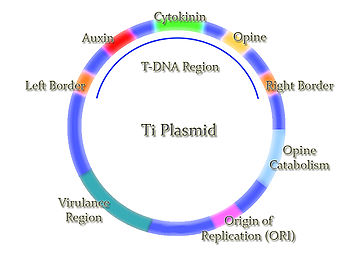
Ti plasmid
Encyclopedia

Plasmid
In microbiology and genetics, a plasmid is a DNA molecule that is separate from, and can replicate independently of, the chromosomal DNA. They are double-stranded and, in many cases, circular...
that often, but not always, is a part of the genetic equipment that Agrobacterium tumefaciens
Agrobacterium tumefaciens
Agrobacterium tumefaciens is the causal agent of crown gall disease in over 140 species of dicot. It is a rod shaped, Gram negative soil bacterium...
and Agrobacterium rhizogenes
Agrobacterium rhizogenes
Agrobacterium rhizogenes is a Gram negative soil bacterium that produces hairy root disease in dicotyledonous plants.A...
use to transduce its genetic material to plants. Ti stands for tumor inducing. The Ti plasmid is lost when Agrobacterium is grown above 28°C. Such cured bacteria do not induce crown galls, i.e. they become avirulent. pTi and pRi share little sequence homology but are functionally rather similar. The Ti plasmids are classified into different types based on the type of opine
Opines
Opines are low molecular weight compounds found in plant crown gall tumors or hairy root tumors produced by parasitic bacteria of the genus Agrobacterium. Opine biosynthesis is catalyzed by specific enzymes encoded by genes contained in a small segment of DNA , which is part of the Ti plasmid,...
produced by their genes. The different opines specified by pTi are octopine, nopaline
Nopaline
Nopaline is one of the Opines. Ti plasmids are classified on the basis of the different types of Opines they produce. These may be Nopaline plasmids, Octopine Plasmids and Agropine Plasmids. These Opines are condensation products of amino acids and keto acids or may be from sugar. The Opines are...
, succinamopine and leucinopine.
The plasmid has 196 gene
Gene
A gene is a molecular unit of heredity of a living organism. It is a name given to some stretches of DNA and RNA that code for a type of protein or for an RNA chain that has a function in the organism. Living beings depend on genes, as they specify all proteins and functional RNA chains...
s that code for 195 protein
Protein
Proteins are biochemical compounds consisting of one or more polypeptides typically folded into a globular or fibrous form, facilitating a biological function. A polypeptide is a single linear polymer chain of amino acids bonded together by peptide bonds between the carboxyl and amino groups of...
s. There is no one structural RNA
RNA
Ribonucleic acid , or RNA, is one of the three major macromolecules that are essential for all known forms of life....
. The plasmid is 206,479 nucleotide
Nucleotide
Nucleotides are molecules that, when joined together, make up the structural units of RNA and DNA. In addition, nucleotides participate in cellular signaling , and are incorporated into important cofactors of enzymatic reactions...
s long, the GC content is 56% and 81% of the material is coding genes. There are no pseudogene
Pseudogene
Pseudogenes are dysfunctional relatives of known genes that have lost their protein-coding ability or are otherwise no longer expressed in the cell...
s.
The modification
Genetic engineering
Genetic engineering, also called genetic modification, is the direct human manipulation of an organism's genome using modern DNA technology. It involves the introduction of foreign DNA or synthetic genes into the organism of interest...
of this plasmid is very important in the creation of transgenic plants, but only in dicotyledon
Dicotyledon
The dicotyledons, also known as dicots, are a group of flowering plants whose seed typically has two embryonic leaves or cotyledons. There are around 199,350 species within this group...
plants.
Virulence Region
Genes in the virulence region are grouped into the operons virABCDEFG, which code for the enzymes responsible for mediating transduction of T-DNA to plant cells.- virA codes for a receptorReceptor (biochemistry)In biochemistry, a receptor is a molecule found on the surface of a cell, which receives specific chemical signals from neighbouring cells or the wider environment within an organism...
which reacts to the presence of phenolic compounds such as acetosyringoneAcetosyringoneAcetosyringone is a phenolic natural product, and is a chemical compound related to acetophenone and 2,6-dimethoxyphenol. It was first described in relation to lignan/phenylpropanoid-type phytochemicals, with isolation from a variety of plant sources, in particular, in relation to wounding and...
, syringealdehyde or acetovanillone which leak out of damaged plant tissues. - virB encodes proteins which produce a pore/pilus-like structure.
- virC binds the overdrive sequence.
- virD1 and virD2 produce endonucleases which target the direct repeat borders of the T-DNA segment, beginning with the right border.
- virG(TRANSCRIPTIONAL FACTOR) activates vir-gene expression after binding to a consensus sequence, once it has been phosphorylated by virA.
Characteristics Features
- Agrobacterium is called the natural genetic engineer.
- Size of the plasmid: ~250 Kbp.
- Contains one or more T-DNADNADeoxyribonucleic acid is a nucleic acid that contains the genetic instructions used in the development and functioning of all known living organisms . The DNA segments that carry this genetic information are called genes, but other DNA sequences have structural purposes, or are involved in...
region. - Contains a region enabling conjugative transfer.
- Contains regions for opine synthesis and catabolism.
- Responsible for crown gall disease in plants.

